Angela Ackerman's Blog: Writers Helping Writers, page 51
May 11, 2022
Want Readers Connect to Your Character? Include this.

Some characters have more shape and weight than others, feeling so authentic we can almost believe they walked right out of the real world. Their emotions, vulnerabilities, needs, and desires ring so true, we can���t help but be pulled in by them. These characters hold us hostage while we read, and as writers, we start analyzing why we care so much so we can duplicate this magic in our own stories.
So, what’s the secret sauce that creates such a powerful connection?
Recognition.
When readers see something within the character that resonates, something they themselves think, feel, or believe in, it becomes common ground that binds them to the character.
But wait, you say. That makes no sense! What does my thirty-two-year-old, baby Yoda collecting schoolteacher-slash-reader have in common with the fiery, laser-zapping sky captain in my steampunk sci-fi?
Oh, not much, except maybe���
The pain of a lossMaking a mistake that can���t be fixedThe agony of hurting a loved oneHow time stretches in a moment of humiliationKnowing a love so pure they���d sacrifice anything for itThe dark thoughts that accompany a desire for revengeFailing and letting others downThe chest-expanding rush of pride or validationThe rush that comes with getting a second chanceExperiencing the sting of betrayalWorrying the past will repeat itselfFinding the courage to live one���s truth���and so on.
Experiences, Good and Bad, Connect Us All
No matter who your character is, human or not, protagonist or antagonist, they will have experiences in common with readers. These may look very different, but in the hands of a strong storyteller, they will be recognizable, holding a core truth that stirs a reader���s thoughts and emotions. In some form, readers feel an echo of having lived the same moment, stood at the same crossroads, or felt the same thing, as the character.
Recognition is a powerful tool, hooking readers and keeping them engaged. By thinking about what it is to be human, and how to use that to find areas of common ground, we can create mirrors within our characters that draw readers in and trigger their empathy.
Two of the best places to look for common ground experiences that will really resonate are Emotional Wounds and Meaningful Goals.
Emotional WoundsTrauma is an unfortunate side effect of life. We all carry the burden of painful experiences ��� you, me, and readers. People can hurt and betray, they can let us down, and we can do the same to them or ourselves.
Anything that is a big part of the human experience is something we should weave into our character building. By brainstorming a character���s emotional wounds, we make them authentic, and it gives us a powerful way to reveal their vulnerabilities to readers.

Emotional wounds come in all shapes and sizes: Betrayal. Humiliation. Rejection. Injustice. Neglect. They cut, bruise, and most importantly, change the character. Just like us, the person a character was before a traumatic event and who they become after will be different. In the aftermath they carry scars in the form of unmet needs, fears, and false beliefs. They may believe they are less worthy, less capable, or somehow at fault. A wounding event can also reshape how the character sees reality, causing them to think people can���t be trusted, that the world is callous and unfair, or believe life���s cards are stacked against them.
Watch how the Character Builder helps you uncover your character’s backstory wounds.
As readers, we may see all the ways their thinking is flawed, yet still understand why they believe what they do. Their experience informs their opinions, just as ours inform us. And even as we root for them to see the truth and be free of their pain, we recognize and relate to the experience of missing what���s right in front of you.
We���ve all experienced wounds and seen loved ones be swallowed up by fear these events create. We���ve witnessed their dysfunctional behavior and unhealthy coping mechanisms cause problems. So when a character misbehaves, lashes out, or holds back because they are afraid of being hurt again in the book we���re reading, we get it. We connect to their struggle. Their fear is our fear. We carry the burden of it together.
Meaningful GoalsImagine a line where an emotional wound is on one end and the other, a meaningful goal. One represents fear, the other hope. And as powerful as fear is, hope can best it, which is why we give characters goals to aim for.

Hope is having trust and belief that something can change. In the story, hope tips the scales in the moment when a character decides what they want is more important than what may hurt them. They hold to hope, step out onto the ledge, and move forward despite fear.
Your character���s goal can be anything: To find a lifelong partner. Succeeding where they once failed. Forgiving themselves. Pursuing justice, Protecting a loved one. The only qualifier is to make this goal meaningful so they have strong motivation to achieve it. When obstacles appear, or adversity and conflict batters them, hope that they can get what they need most keeps them on course.
And beside them as always is the reader, willing them to succeed. Neck bent, readers consume words, desperate to know the outcome because the biggest recognition of all is unfolding: a shared journey.
Character Arc: Where Readers and Characters CollideWhy are readers so fascinated by the character���s journey? After all, it���s only fiction right, a bit of entertainment, an escape.
Or…could it be something more?
Okay, that���s a trick question. A character���s journey to leave behind a hurtful or limiting past and cross into a better, more fulfilling future should remind you of something because life is a series of journeys. Like the character, we are always moving toward a better tomorrow. We yearn for internal completeness just as they do, so when we read, we recognize the steps they take, and the courage, growth, and sacrifice along the way. We root for characters to win because deep down, we are rooting for ourselves to win, too.
So, when you write, find common ground. Put those shared experiences on the page for readers to recognize! Readers should see themselves in the character���s vulnerability and uncertainty, their wounds and fears. But most of all, showcase the character���s hope and goals. These remind readers what���s worth fighting for both in fiction, and in life.
Need help with character’s arc? This tool pays attention to certain details as you brainstorm them and creates a Character Arc Blueprint for you.
The post Want Readers Connect to Your Character? Include this. appeared first on WRITERS HELPING WRITERS��.
May 8, 2022
10-Year Celebration: Win the Ultimate Writer’s Toolkit

So, today is a big anniversary for Becca and me because ten years ago to the day we hit the publish button on The Emotion Thesaurus.
10 Years. Can you believe it?
We wrote this book hoping to help others who struggled with showing character emotion, but deep down, we were terrified. It was our first book. We were nobodies…who would take us seriously? And we were self-publishing at a time when the industry wasn’t too fond of that just yet.
We had no idea it would go on to become so well-loved book. And oh my gosh, guys–thank you so much for that!
Many of you have told us the Emotion Thesaurus never leaves your desk, and it’s hard to describe how good that makes us feel. Talk about honored. It got us thinking about the many other must-have resources that help writers create, publish, and build satisfying careers. That led to a very big question:
What would the Ultimate Writer’s Toolkit look like?
So, we polled other writers, made a list of the best of the best, and then reached out to the leaders in our industry to see if they would help us build an ULTIMATE toolkit and give it away.
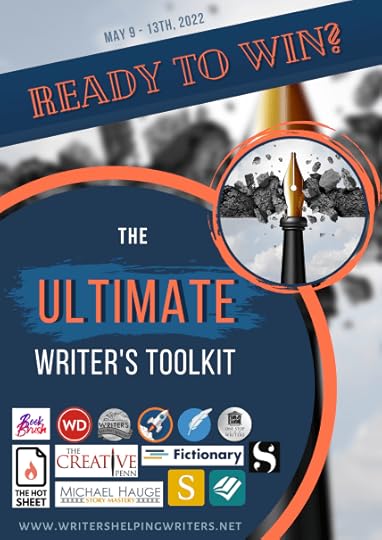 The Ultimate Writer’s Toolkit Giveaway
The Ultimate Writer’s Toolkit Giveaway

Buckle in, writers, because one of you will win…
A 1-Year Subscription to Jane Friedman’s The Hot Sheet: An award-winning newsletter that will keep you up to date on the market, industry news, author earnings, trending topics, and new opportunities. (Value: $59)

Writer’s Digest’s Get Published in 2022 Bundle: Nine amazing resources to help you stay productive, get published, and keep a positive mindset, so you reach your creative goals. (Value: $79.99)

Joanna Penn’s Author Business Plan Course: Learn the elements of an effective business plan, questions you need to answer to discover what lies behind the plan, and how to act on decisions made to take your author career to the next level. (Value: $99)

A 1-Year Subscription to One Stop for Writers: Everything a writer needs to create fresh, breakout fiction: powerful character and plotting tools, worldbuilding surveys, worksheets, the largest show-don’t-tell database available anywhere, and a Storyteller’s Roadmap to guide you from that first idea all the way to a publish-ready book. (Value: $105)

A Scrivener Writing Software License: Provides all you need to write and brings together your notes, research, and writing���so it���s always at hand. It also lets you set word targets for your entire manuscript or for the current writing session���which can be great motivation. (Value: $49)

A 1-Year ProWritingAid License: More features than any other manuscript editing software on the market! Improve your writing quickly and efficiently with thousands of grammar, spelling and readability improvements delivered in real-time as you write. (Value: $79)

The Hero’s Two Journeys Video Access: Two of Hollywood���s top Story Experts, Michael Hauge & Chris Vogler, reveal the secrets of mastering Plot Structure, Character Arc, Identity, Essence, Archetype and Theme. (Value: $39)

A 1-Year Subscription to StoryTeller: Get ready for revision to get a lot easier! Use Fictionary’s 38 Story Elements to evaluate your story scene to scene so only your best writing makes it to the page. (Value: $200)

A 1-Year Premium Membership to The Critique Circle: Continuously improve your writing by critiquing others and building relationships with authors who will help with your manuscripts. You can receive multiple critiques and compare feedback to see what���s working and what areas need to be strengthened. (Value: $50)

A Publisher Rocket License: Publisher Rocket helps get your book in front of more Amazon shoppers with four tools to increase book sales. It makes finding keywords, sizing up the competition, and choosing profitable categories quick and easy. (Value: $97)

A 1-Year Subscription to Book Brush: The easiest way to create professional ads, social media images, and 3D book covers using author-specific stamps, templates and animations. (Value: $99)

A 1-Year Subscription to StoryOrigin: Build your mailing list, increase sales, and find reviewers for your book all in one place. Everything an author needs to super-charge their marketing! (Value: $100)

A Writers Helping Writers Thesaurus Set*: Nine bestselling writing guides to help you activate the power of show-don���t-tell to involve readers more deeply in the world, events, and emotional undercurrents of your book. *US winner: print, International winner: digital. Emotion Amplifiers is digital only
Say, are you drooling?
It’s okay, we don’t blame you!
We can’t wait to see who wins this unbelievable writing toolkit. It won’t just improve someone’s writing – it will accelerate their career!
Runner-Up Prize Alert!Because Writer’s Digest is so generous, they are also offering a runner-up prize:

Writer’s Digest NaNoWriMo Prep Bundle: Tons of tools to get your creativity flowing, keep you motivated, and complete your first draft in 30 days. ($56.99)
Thank you to all the generous sponsors who contributed to this Ultimate Writer’s Toolkit!
A little something from Becca & Angela
Many of you have The Emotion Thesaurus, either the original (75 emotions), or the 2nd edition (130 emotions), but you may not know it’s also at One Stop for Writers where we expand it from time to time.
In fact, we recently added 5 NEW EMOTIONS: Joy, Indignation, Misery, Giddy, and Revulsion, so if you like, start a 2-week free trial to check out these entries (and the rest of the database), or…
Give yourself a 30% discount by using the code EMOTION when you sign up to any paid plan.
(Code valid until May 18th, 2022.)
Ready to enter the Giveaway? Find it below & good luck!All the usual giveaway legalese applies – no purchase necessary, must be 18, and the winner is subject to our giveaway policies here. Additionally, these prizes have no cash value and cannot be exchanged. Some may have a time limit for redemption or other prize-specific conditions.
a Rafflecopter giveaway
The post 10-Year Celebration: Win the Ultimate Writer’s Toolkit appeared first on WRITERS HELPING WRITERS��.
May 5, 2022
Phenomenal First Pages Contest
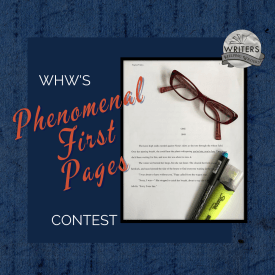 Hey, wonderful writerly people! It���s time for our monthly first-page critique contest
Hey, wonderful writerly people! It���s time for our monthly first-page critique contest 
If you���re working on a first page (in any genre except erotica) and would like some objective feedback, please leave a comment. Any comment :). As long as the email address associated with your WordPress account/comment profile is up-to-date, I���ll be able to contact you if your first page is chosen. Just please know that if I���m unable to get in touch with you through that address, you���ll have to forfeit your win.
Two caveats:
 Please be sure your first page (double-spaced in 12-point font) is ready to go so I can critique it before next month���s contest rolls around. If it needs some work and you won���t be able to get it to me right away, let me ask that you plan on entering the next contest, once any necessary tweaking has been taken care of. Resources for common problems writers encounter in their opening pages can be found here.
Please be sure your first page (double-spaced in 12-point font) is ready to go so I can critique it before next month���s contest rolls around. If it needs some work and you won���t be able to get it to me right away, let me ask that you plan on entering the next contest, once any necessary tweaking has been taken care of. Resources for common problems writers encounter in their opening pages can be found here.
 This contest only runs for 24 hours, start to finish, so get your comment in there!
This contest only runs for 24 hours, start to finish, so get your comment in there!
Three commenters��� names will be randomly drawn and posted tomorrow morning. If you win, you can email me your first page and I���ll offer my feedback.
We run this contest on a monthly basis, so if you���d like to be notified when the next opportunity comes around, consider subscribing to our blog (see the right-hand sidebar).
Best of luck!
PS: If you want to amp up your first page, grab our helpful First Pages checklist from One Stop for Writers. And for more instruction on these important opening elements, see this Mother Lode of First Page Resources.The post Phenomenal First Pages Contest appeared first on WRITERS HELPING WRITERS��.
May 3, 2022
Using Crisis to Reveal Character

By September C. Fawkes
In the writing community, a crisis (also known as a ���dilemma���) happens when a character has to choose between two opposing things. And he can���t have both.
Shawn Coyne, author and creator of The Story Grid, breaks crises down into two types:
a. The Best Bad ChoiceThe character has to choose between two negative options.
Ex. Katniss Everdeen has to either kill Peeta, or risk killing herself.
b. Irreconcilable GoodsThe character has to choose between two positive options.
Ex. A protagonist has to choose between the job of her dreams, or the man of her dreams.
While the categories are helpful when teaching and talking about crises, in many stories, the options may not be obviously ���good��� or ���bad.��� For example, in The Hobbit, Bilbo Baggins gets called on an adventure. He has two options: Refuse and continue to live his predictable life, which invites a sort of personal stagnation, or accept and risk danger and death, which include gaining personal experience and growth. From the audience���s perspective, we may say that going on the adventure is the best, and obvious choice, but that isn���t how it looks to the character. Each option has both negative and positive stakes tied to them: Stay safe and alive, but somewhat stagnant, or risk danger and death, and grow through experience.
While traditionally crises are talked about with pairs of options, it���s technically possible to have more than two things to choose from���the keys are that the choice needs to be difficult, irreconcilable, and hard���if not impossible���to reverse (at least not without significant ramifications). It���s also possible that in some crises, not making a choice is an option, but for that to work, it needs strong stakes.
The crisis is a moment where we lay out current stakes and the directions the story could go, depending on what the character chooses. This reinforces the character���s agency, and what the character selects will reveal a lot about him or her. In fact, a crisis is one of the most effective ways to reveal true character.
When Katniss chooses to risk killing herself over simply killing Peeta, it reveals that, when it gets down to it, she���s more willing to sacrifice herself in an effort to protect the innocent, than others to benefit herself. In contrast, President Snow and the Capitol repeatedly pick the opposite. When a character chooses her dream job over her dream man, it shows she values her career more than her romantic relationships. And when Bilbo accepts Gandalf���s invitation, it reveals he���d ultimately rather risk danger and death to experience adventure.

A crisis helps indicate a character���s true belief system. It���s easy to proclaim we will do something when there are no stakes or competing choices. I might insist repeatedly that I always tell the truth . . . but if telling the truth could get me fired, leaving my family with little to eat, I face a difficult decision. Do I value honesty or food more? To dig a little deeper, we may ask why I value one over the other, or how I came to value one over the other.
Crises can also be very effective in character arcs. If you are writing about a protagonist who changes because of the story, you may use a crisis at the beginning of the story to reveal what the character initially values. For example, I may show our protagonist choosing her work over her boyfriend. At the end, you may choose a similar crisis to show how the character now believes differently. Our protagonist chooses the man of her dreams over the job of her dreams. If you are writing a steadfast (also known as a flat-arc) protagonist, you will show how the protagonist ultimately chooses the same option, despite the added pressure of the climax. Katniss initially chooses to risk sacrificing herself to protect Prim. Regardless of what the Games have tempted her to do, she ultimately makes the same choice to try to protect Peeta.
Because crises emphasize agency, they also put responsibility on the protagonist. When he chooses an option, he���s also choosing its ramifications. If Katniss killed Peeta, she���d have to live with that, but she���d be safe. Because she didn���t, she puts herself, family, and ultimately all of the districts at risk. She now has to deal with the consequences of that.
Crises can be a great way to create internal conflict and also plant seeds of doubt and regret, as the character may be haunted by her choices and the accountability they bring.
Using crises will strengthen any story, particularly by revealing character.
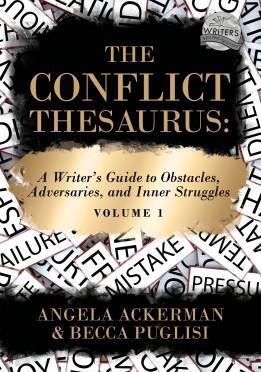 Need help designing conflict scenarios that will generate a crisis?
Need help designing conflict scenarios that will generate a crisis? The Conflict Thesaurus has over 100 different scenarios that will challenge your character inside and out. Find out more.
 September C. Fawkes
September C. FawkesResident Writing Coach
September C. Fawkes has worked as an assistant to a��New York Times��bestselling author and writing instructor, and now does freelance editing at FawkesEditing.com. She has published poetry, short fiction, and nonfiction articles, and her award-winning writing tips have appeared in classrooms, conferences, and on Grammar Girl. Grab this AMAZING guide on Crafting Powerful Protagonists at her website and find her on
Twitter �� Facebook �� Instagram �� Tumblr
The post Using Crisis to Reveal Character appeared first on WRITERS HELPING WRITERS��.
April 30, 2022
Fear Thesaurus Entry: Agoraphobia
Debilitating fears are a problem for everyone, an unfortunate part of the human experience. Whether they’re a result of learned behavior as a child, are related to a mental illness, or stem from a past wounding event, these fears influence a character’s behaviors, habits, beliefs, and personality traits. The compulsion to avoid what they fear will drive characters away from certain people, events, and situations and hold them back in life.
In your story, this primary fear (or group of fears) will constantly challenge the goal the character is pursuing, tempting them to retreat, settle, and give up on what they want most. Because this fear must be addressed for them to achieve success, balance, and fulfillment, it plays a pivotal part in both character arc and the overall story.
This thesaurus explores the various fears that might be plaguing your character. Use it to understand and utilize fears to fully develop your characters and steer them through their story arc. Please note that this isn’t a self-diagnosis tool. Fears are common in the real world, and while we may at times share similar tendencies as characters, the entry below is for fiction writing purposes only.
 Agoraphobia
AgoraphobiaNotes
Agoraphobia is an anxiety disorder that causes people to be afraid of the places or situations that could bring on a panic attack. Their fear of being unable to get help or escape during one of these attacks can make it difficult for them to navigate open spaces, elevators, crowds, concerts, church services, movie theaters, or any place where a panic attack might come on. In extreme cases, a character suffering from agoraphobia may reach the point where they’re uncomfortable leaving their home at all.
What It Looks Like
Frequent panic attacks or elevated anxiety in certain places
Consistently avoiding certain locations or situations
Making choices that enable the character to stay at home (working from home, having groceries delivered, etc.)
The character often declining social invitations to certain places (amusements parks, church services, weddings, etc.)
Only venturing outside with a companion
Clinging to the friends or family members who are supportive
Becoming isolated
Common Internal Struggles
Wanting to not be limited by a fear but it being too strong to ignore
Knowing the fear is irrational but being being compelled to give in to it
Feeling guilty for making excuses about not being able to attend certain events
The character feeling like they can’t trust their own mind or emotions
Feeling defective or broken
Becoming depressed
Slipping into despair���believing that things will never change or get better
Wanting to seek help but feeling too overwhelmed or incapable
Feeling misunderstood and alone, as if the character is alone in their suffering
Worrying about what others think
Flaws That May Emerge
Addictive, Compulsive, Cynical, Defensive, Evasive, Inhibited, Insecure, Needy, Nervous, Obsessive, Self-Destructive, Timid, Withdrawn
Hindrances and Disruptions to the Character’s Life
Being unable to do things the character would like to do
Having to lie or make excuses for why they can’t attend an event
Missing out on interactions with others
Not being offered (or not being able to accept) job advancement opportunities
Settling for a career that isn’t exactly what the character wants because it enables them to work from home or a certain location
The character’s outings being contained to a finite area because they’re unable to drive or use public transportation
Being dependent on medications with undesirable side effects
Depending on others; the character having to arrange their day and outings around the people who can go places with them
Being exhausted and mentally depleted after an outing
The fear of a panic attack bringing on panic attacks
Scenarios That Might Awaken This Fear
Losing someone who understood and cared for the character
Experiencing a stressor (getting in a car accident, being victimized, losing a job, etc.)
Having to go to a location that is a known stressor for the character
A change in circumstance that makes it harder to avoid stressors���totaling a car and having to rely on public transportation, for instance
Feeling the beginnings of panic or an elevation in anxiety
Seeing looks of pity or disdain from others when the character is struggling with panic or anxiety
Other Fear Thesaurus entries can be found here.
 Need More Descriptive Help?
Need More Descriptive Help?While this thesaurus is still being developed, the rest of our descriptive collection (16 unique thesauri and growing) is accessible through the One Stop for Writers THESAURUS database.
If you like, swing by and check out the video walkthrough for this site, and then give our Free Trial a spin.
The post Fear Thesaurus Entry: Agoraphobia appeared first on WRITERS HELPING WRITERS��.
April 28, 2022
You Wrote a Killer Love Story���But Did You Romance the Reader?

So many ingredients go into writing a strong romance. As with any other genre, we want to develop characters who are complex, fresh, relatable, and unique. They should have strong motives and desires, but also be a bit broken too, people who have been hurt by life, suffered disappointments, and see struggle. They will have had past relationship interactions that have changed them in positive or negative ways but ultimately have left them with a skewed vision on what future ones will look like. This will be a focus in the story as they meet someone they are attracted to that challenges their ideas of what a relationship can be, and awakens their desire to risk their heart in away they didn���t believe they would be capable of doing.
The story will also have tension ��� disagreements, misunderstandings, beliefs that clash, and possibly other forces that stand in the way, but eventually unmet love and belonging needs, and the story stakes will push the characters to fight through resistance, fears, and differences so each can become the other���s missing piece.
Bringing two people together, especially ones who may be jaded, initially mistrustful, and worried about being hurt by love again, must be handled with care to feel credible. They should be individuals focused on their own realities and goals, and yet their uniqueness, personality, values, and strengths are a perfect fit for the other person, so much so that fighting it is futile.
Writers of romance are obviously very focused on creating the perfect chemistry between the protagonist and love interest, but there���s a third person they also need to think about as they craft this complex tapestry of love: the reader.
If the reader doesn���t fall in love with the couple, the story flops, so they too need to be wooed. This can be tricky because each reader comes to the story with specific beliefs, needs, and ideas of what makes a good partner. Somehow, we need to make them see these two are perfect for each other, and the love interest is worthy of the protagonist.
One route to doing this is thinking about what women (the majority of romance readers) find attractive or admirable. So if you are looking for little ways to get readers to buy into your choice of a love interest for the protagonist, consider the following areas:
 A Sense of Humor
A Sense of HumorThere���s something very likable about people who see humor in the day to day, and especially if they can laugh at themselves occasionally. If your Love Interest displays this, a reader will warm to them.
Following ThroughIn a world where excuses are often made, plans are sidelined and people are marginalized, holding one���s word is important to women. How can your Love Interest follow through in some small way that shows what kind of guy he is?
Emotional PerceptivenessIn the real world some men struggle with expressing emotions as doing so makes them feel vulnerable. Communication is important in any relationship however, so especially in situations where a love interest is male, showing their willingness to voice feelings that may be difficult or ask perceptive questions that go beneath the surface are two things that will catch the attention of women readers. It needs to be organic, though. A love interest, male or female, that opens up the floodgates to their feelings when it isn���t their nature to do so won���t feel authentic. Find a balance that is believable.
A Willingness to HelpWomen appreciate it when someone pitches in unasked. This shows the person is observant and willing to pull their own weight. If your Love Interest finds an opportunity to do this, they will endear themselves to female readers.
Good MannersCommon decency goes a long way: holding a door, offering a genuine compliment without strings, or even standing up on a bus so an elderly man can take a seat. Manners count, and women notice.
GenerosityAnother quality women appreciate is the willingness to give time or resources to another, even when it isn���t asked for or expected. This shows women that your love interest looks beyond themselves and is perceptive to what others need.
Quiet ConfidenceThere is something highly attractive about a love interest who is confident but doesn���t need to prove it through grand gestures, overly decisive decision-making, situational control, or showiness. They are who they are, and don���t need to do things for approval or to impress.
Being a Good ListenerWomen like to feel they are being heard, so if you can demonstrate this in your book, do so. This doesn���t mean a scene where the protagonist pours out their heart while your love interest faithfully listens, just a small moment in the story where your love interest acts thoughtfully BECAUSE they were listening.
Providing SupportWomen are hardwired to place importance on security and family, so they approve of a love interest that has their life together: a steady job that shows they can contribute financially, maturity to be a good role model if the protagonist has a family, etc. Set the foundation to show that your love interest has the makings of a good life partner.
Another aspect of likability is when a reader identifies with the love interest because they exhibit qualities that earns their respect. Let���s look at a few of those as well.
Being Low MaintenanceWomen are often mothers, wives, and have careers. They work hard and will have little patience for a love interest who is needy, immature, or full of dramatics.
IndependenceWomen respect independence. The love interest should be their own person and while their deep connection with the protagonist will complete them, the romance and ���needing to be loved��� should not be their only reason for being in this story. Flesh them out so they are complex and real, not arm candy.
Being a FighterWomen fight for what they want, and who. The love interest shouldn���t quit at the first roadblock. Determination is what women want to see: wanting something bad enough to endure hardship or emotional discomfort to get it.
Inequity StrugglesWomen often endure challenges tied to their gender, ones that place limitations on them or come with double standards. This leads to anger, impatience, and resentment, but if the circumstances to change things are outside their control, they must also find a way to move forward. Showing a love interest who similarly struggles with gender bias, discrimination, intolerance, or racism will help women feel solidarity and empathy for the character.
Having Realistic FlawsWomen are bombarded by media that reinforces they should prioritize looking better, standing out, and that they should do what they can to hide aging and lose extra weight. This reinforces the idea that how we look is more important than who we are. Women readers will likely not connect well to a love interest who looks and acts perfect, so stay away from the ���flawless��� stereotype. People are flawed, readers are flawed. Characters should be, too.
That���s my list���do you have anything to add?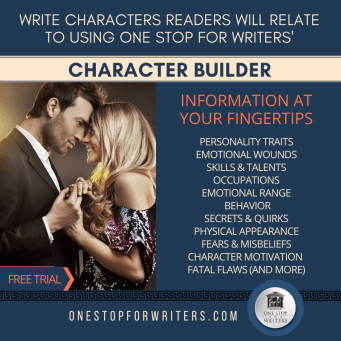
I hope this gives you some ideas on how to create a love interest for your protagonist that readers will feel good about. If you need more help, check out One Stop for Writers��� Character Builder. Not only are there guidelines for brainstorming a Love Interest, this tool will help you explore a character���s deepest layers so you can write their behaviors, actions, and decisions authentically on the page.��
The post You Wrote a Killer Love Story���But Did You Romance the Reader? appeared first on WRITERS HELPING WRITERS��.
April 26, 2022
What’s Your Character Hiding?

Being able to write realistic, consistent, multi-dimensional characters is vital to gaining reader interest. Doing so first requires we know a lot about who our characters are���you know, the obvious stuff: positive and negative traits, behavioral habits, desires, goals, and the like. But it���s not always the obvious parts of characterization that create the most intrigue. What about the things your character is hiding?
Everyone hides. We hide the goals we know are wrong for us, opinions that may turn others against us, or feelings and desires that make us feel vulnerable���basically anything with the potential for rejection or shame.
The same should be true for our characters. When characters are cagey out of a need to protect themselves from emotional harm, readers understand that. It makes the characters more authentic and can pique your readers��� interest as they try to figure out the secret or worry over what will happen when it comes to light.
7 Things Your Character Is HidingTo add this layer of depth to your characters, you first need to know what���s taboo in their minds���not only what they���re hiding, but why. Here are some common things your character may feel compelled to conceal from others.
1. DesiresDesires are an important part of who your characters are. These desires drive their actions and decisions in the story. While these wants are often transparent, there are situations in which the character may not feel comfortable sharing them.
Maybe she���s secretly pining for her sister���s ex, or she longs for a career forbidden by her parents, or she wants to fight her boss���s unethical behavior but is afraid of losing her job.
Forbidden or dangerous desires can add an element of risk, upping the stakes for the character and making things more interesting for readers.
2. FearsEveryone has fears. Many of those fears are perfectly acceptable, which makes it safe for us to share them. It���s the ones that make us feel weak or lessen us in the eyes of others that we keep in the dark.
Think about really debilitating fears, such as being afraid of a certain people group, physical intimacy, or of leaving one���s house.
Fears like these should always come from somewhere���maybe from a wounding event or negative past influencers. Make sure there���s a good reason for whatever your character is afraid of.
3. Negative Past EventsSpeaking of wounding events, we each have defining moments from the past that we���re reluctant to share with others or even acknowledge ourselves.
What���s something that could have happened to your characters that they���ll go to great lengths to keep hidden? What failures or humiliating moments might they alter in their own memories to keep from facing them?
Wounds are formative on many levels, so it���s important to figure out what those are and how they may impact the character.
4. Flaws and InsecuritiesBeing flawed is part of the human experience. There are things about ourselves we don���t want to examine too closely and which we definitely don���t want others to know about.
For characters, these flaws often manifest as insecurities or negative traits (such as being weak-willed, unintelligent, or vain). Whether these weaknesses are real or only perceived, characters will try to downplay them.
But part of their journey to fulfillment includes facing the truth and acknowledging the part their flaws play in holding them back. To write their complete journeys, your need to know what weaknesses they���re keeping under wraps.
5. Unhealthy BehaviorsSometimes characters exhibit behaviors or habits they know aren���t good for them. Maybe these behaviors stem from a wounding event or an unhealthy desire. Maybe they really want to change, but they don���t know how.
Whether it���s an unhealthy relationship with food, a gambling addiction, or a compulsion to self-harm, they���ll expend a lot of energy to keep these behaviors hidden.
Revealing these behaviors to readers, while hiding them from other characters, is a great way to remain true to the human experience while also building reader interest.
6. Uncomfortable Emotions
While it���s healthy to embrace and express a range of emotions, characters are not always comfortable with all the feelings. This may occur with emotions that are tied to a negative event from the past. It may be an emotion that makes the character feel vulnerable or is culturally unacceptable.
The character will want to mask any uncomfortable emotions, often disguising them as something else: embarrassment is replaced with self-deprecation, or fear manifests as anger. This duality of emotion is important because it humanizes characters for readers and adds a layer of authenticity that might otherwise be missing.
7. Opinions and IdeasEveryone wants to be liked. To gain the respect of others, we often go so far as to sacrifice honesty.
If an opinion isn���t popular, your characters may keep it to themselves. If they have good ideas others won���t appreciate, they won���t share them���or they���ll get the ideas out there in a way that allows them to avoid taking ownership.
Peer acceptance is important to everyone; that need, and the secrets that accompany it, is something that every reader will be able to relate to.
Deception���whether deliberate or subconscious���is part of the human experience. When your characters hide things from others, they become deeper and more layered and avoid turning into clich��s. They���ll come across as more authentic to readers, who will be able to relate to them. It also can build empathy as readers see the character headed the wrong direction. A lot of good can result from taking the time to discover what your characters are hiding. So put on your Nosy Pants and get to work!
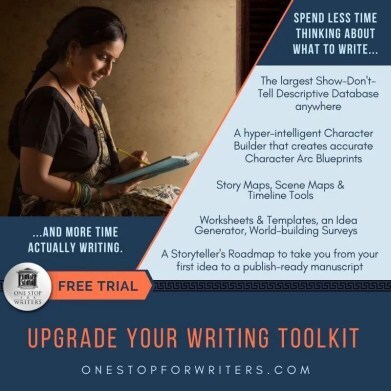 One Stop For Writers can help you dig deeper
One Stop For Writers can help you dig deeper Your character has reasons for hiding what they do, so it’s important to know what those are. Uncover your character’s emotional wounds, secrets, personality traits, motivations and more using this powerful thesaurus database and character builder tool.
Grab the code SPRINGWRITER to save 25% on all One Stop plans until April 28th, 2022.
The post What’s Your Character Hiding? appeared first on WRITERS HELPING WRITERS��.
April 22, 2022
Fear Thesaurus Entry: Putting Yourself Out There
Debilitating fears are a problem for everyone, an unfortunate part of the human experience. Whether they’re a result of learned behavior as a child, are related to a mental illness, or stem from a past wounding event, these fears influence a character’s behaviors, habits, beliefs, and personality traits. The compulsion to avoid what they fear will drive characters away from certain people, events, and situations and hold them back in life.
In your story, this primary fear (or group of fears) will constantly challenge the goal the character is pursuing, tempting them to retreat, settle, and give up on what they want most. Because this fear must be addressed for them to achieve success, balance, and fulfillment, it plays a pivotal part in both character arc and the overall story.
This thesaurus explores the various fears that might be plaguing your character. Use it to understand and utilize fears to fully develop your characters and steer them through their story arc.
 Fear of Putting Yourself Out There
Fear of Putting Yourself Out ThereNotes: Have you ever voiced an idea or offered to step up only to be met with a scoff or outright dismissal? If so, you know what it’s like to feel minimized, and each time it happens, it becomes harder to put yourself out there.
Characters who have been shot down repeatedly may start to fear it will always happen when they try to step up or add their ideas, and so they stop doing so. This fear can lead to severe frustration (as the character feels stymied), as well as low self-worth.
What It Looks Like
Keeping to the background
Not speaking up or sharing ideas (unless forced to)
The character keeping their head down at work
Doing what they are told, even when they disagree with it
Not sharing passions, interests, or ideas for fear of being mocked
Not sharing achievements or personal good news
Avoiding people with big personalities who have egos to match
Passing on ideas to others who will be taken seriously
Not wanting to talk about themselves and shifting the focus to someone else
Avoiding risky topics in a conversation (to keep the status quo)
Not bidding on a job or applying for a promotion
Avoiding competitive situations
Not volunteering because they believe they won’t be wanted
Making anonymous suggestions or feedback
Avoiding situations that could lead to being in the spotlight
Underachieving to avoid failures that others will judge
Staying in the comfort zone
Choosing to be around people who are “safe” because they share common ground
Self-monitoring behavior to make sure it aligns with what others do
Difficulty with self-advocating
Having a hard time saying no or asking people to respect boundaries
Becoming a perfectionist
Seeking out extra training or education to the point of becoming over-qualified
Not approaching others in social situations
Avoiding arguments
Hesitating and reading the room before voicing thoughts or suggestions
Waiting to be noticed rather than interjecting
Doing what others want to do rather than make suggestions that can be shot down
Not saying anything when people joke the character is too quiet or not assertive enough
Being sensitive to jokes or friendly jabs
Choosing to stay home rather than go out
Common Internal Struggles
Frustration at feeling held back, especially when a bias is at work (not being taken seriously because of their age, gender, or other identifier)
Having to keep anger in check
Wanting something but self-doubt making it hard to follow through (entering a contest, applying for a position in management, asking someone for a date)
Wanting to become more assertive but being unable to
Beating themselves up for what they should have said and done but didn’t
Believing the lies (that they aren’t qualified, that they are too young, etc.)
Flaws That May Emerge
Defensive, Gullible, Inhibited, Insecure, Irresponsible, Jealous, Martyr, Nervous, Obsessive, Oversensitive, Perfectionist, Resentful, Subservient, Timid, Uncommunicative, Weak-Willed, Withdrawn
Hindrances and Disruptions to the Character’s Life
Having to make excuses to not go out with friends
Wanting what others have (fulfilled dreams, relationships, achievements, etc.)
Missing out on a promotion or job position the character is perfect for
Wanting to date someone but they get tired of waiting and move on to someone else
Well-meaning friends trying to ‘fix’ the character (coaching them to be more assertive, stand up and be noticed, swing for the fences, etc.) as if this is easy to do
Being taken advantage of because they can’t set boundaries
Scenarios That Might Awaken This Fear
Being asked to take on a task that will be scrutinized
Discovering a contest or competition that offers a reward that will see the character’s dream realized
Being financially strapped and having to ask for a raise
Asking someone to go out on a date
Having to market and promote a product the character created
Meeting a partner’s family for the first time
Other Fear Thesaurus entries can be found here.
 Need More Descriptive Help?
Need More Descriptive Help?While this thesaurus is still being developed, the rest of our descriptive collection (16 unique thesauri and growing) is accessible through the One Stop for Writers THESAURUS database.
If you like, swing by and check out the video walkthrough for this site, and then give our Free Trial a spin.
The post Fear Thesaurus Entry: Putting Yourself Out There appeared first on WRITERS HELPING WRITERS��.
April 21, 2022
How Writers Can Turn the Page This Spring
We all may write different things, but i’m betting we have one thing in common – a writing process. We sit down, favorite writing tools at the ready. Maybe we light a candle, put on a soundtrack, read an inspirational message taped to the monitor or some other ritual, all because we know that certain things put us in a better frame of mind to create.

For writers, mindset is everything. It can’t be understated – having a positive attitude and strong self-belief keeps us focused and motivated. It sustains us during the long road to a publish-ready story.
Writing is hard work, and unfortunately life doesn’t always make it easy. Hardship and strain can sap our energy, and with everything going on in the world today following on the heels of a difficult past two years, many are reaching our limits as to what they can manage.
So when our mental tank is empty, how do we get to a place where we’re excited to write?This is where there’s good news for anyone living in North America, because it’s now spring, and whether we consciously think about it or not, the seasons impact our mood and mindset. We make certain associations with each season, and in spring, these associations can be leveraged to boost our energy levels, creativity, and outlook.
Using seasonal symbolism to shift your mindset
Winter acts as a long sleep, with most of us content to hibernate a bit. We slow down, hole up inside, and wait out colder temperatures with plenty of snacks, blankets, and tea. And after a long year, we’re in need of that rest. But when spring comes, it’s the wake-up hit we need, bringing an abundance of earthy smells, green shoots, and sunlight to warm our bones.
This is our cue to pull back the metaphorical blanket and look ahead with fresh eyes. We’re naturally more curious, expectant, and energized during this part of the calendar year.
Spring is a time of new perspectives, fresh starts, and blank pagesSpring brims with symbolism that represents growth, renewal, healing, and hope. It reminds us what’s possible, and ignites our excitement to discover our own potential. This can offset lower moods and help us push back negativity.
If we embrace the idea of a new beginning, our mindset recalibrates. We can start to view the future more clearly and think about what our creative goals are, and that motivates us to get going. Maybe we will decide to dive back into a WIP with renewed vigor, start something new, or even switch gears and experiment a bit.
Want to use the symbolism of spring to full advantage? Here are four tips.
1) Think about what you need right now
It’s been a challenging few years, and some of us are feeling the strain, so the first order of the day is to consider what you need, and how creativity can help strengthen you. Take some time to think about what energizes you. If it’s reading, read. If it’s writing, write. And if you need to take a break from social media, certain responsibilities, or something else, give yourself space and grace to do that. It’s okay!
2) Start smallWhen the calendar turns to a new year, many set big, audacious goals in hopes of it being a productive year. This works well for some, but for others it can paralyze them because here they are, a few months in, and those goals seem too big to achieve. Spring is a great time to reassess what you want to accomplish, and possibly reset your goals to something more manageable.
And whatever those goals are, it’s important to break them down into achievable steps. Being successful in small increments is what keeps us moving forward and feeling good about our progress.
Think about what you want to accomplish with this year, and then focus on the first step. For example…
If you want to write a new story, start by getting to know the main character.
If you want to revise a novel, start with your first pages and follow a revision plan.
If you want to try a new genre, read a few books first.
If you want to query a novel, start by researching agents or learn about writing queries.
If you want to self-publish, deepen your understanding of the steps ahead.
And if you’re just trying to get comfortable writing, read this.

Spring is a great time to shake things up, and when we do, it can free up our imagination and our spirits. Stories come in different sizes and shapes, so if a break from your usual projects will help, why not fool around a bit? Step outside your genre box, or try a different type of story. If you write short stories, try a novel, or if you write novels, experiment with flash fiction, a drabble, or try fan fiction for fun.
But if you are firm on the type of length you like, there are other ways to experiment, like changing up the type of plot in your next story. If you need ideas, download this Save the Cat Plot Types List.
4) Explore what works and evolve your toolkitThe resources we keep close to hand have a big impact on our success, but as we evolve as writers, we may need to adjust our writing toolkit. We are constantly growing and evolving, and as we learn, we realize we need help in certain areas. Here are a few places to look for help.
Find other writers. We can learn a lot from other writers because everyone has different strengths and experiences. Getting feedback on your writing, advice on what to do, and having others to be accountable to are all great reasons to get involved in a writing community.
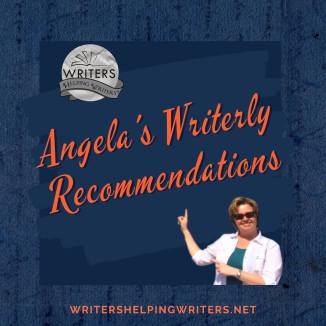
Expand your reading library. There are so many terrific writing guides out there, it’s hard to know where to start. Here are some of our favorite writing guides, but this list and this one are both great, too. Or browse Amazon’s bestselling list for writing guides. (Affiliate link)
Look for new tools to help you. We’re very lucky in that there are so many resources out there to help us plan, write, revise, publish, and market. No matter what you need help with, you can find tools to help you.
Here are the sites I recommend the most to writers – it’s a must-bookmark!
If spring has you energized to try something new…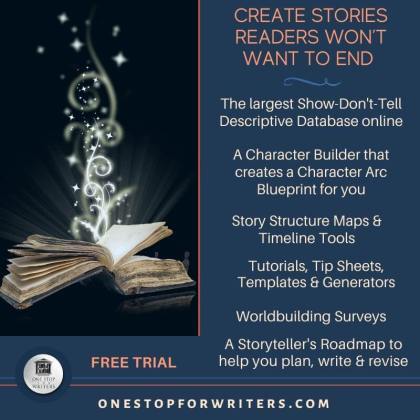
Now’s a good time to head over to One Stop for Writers. You can activate a free trial and use it to build a new character, plot a new story, brainstorm a new world, or use the Storyteller’s Roadmap to see what the next step is for you in writing your current novel.
TIP: If you decide this is something to add to your toolkit, grab this code to save yourself 25%.
Now, one last great thing about spring? Easter chocolate is on sale (you know, in case you need to replenish your stockpile of writerly rewards!)
Spring is reminding you of your potential, so go make something amazing!The post How Writers Can Turn the Page This Spring appeared first on WRITERS HELPING WRITERS��.
April 19, 2022
One Quick Reason Readers Cheer For Unlikable Characters

By Lisa Hall Wilson
How do we get readers to cheer for unlikable characters? We cheer for anti-heroes and characters who are surly, have anger issues, and even questionable morals. Why? They all have one thing in common but it means we have go right back to the basics.
I came across this post from Writers Helping Writers on 10 Ways To Make Your Character Likable. It was a good post though brief. You could do some of your own research into any of the methods mentioned there to strengthen your writing.
Locate The Main Story ThreadSometimes we make things more complicated than they need to be, don���t we? I am prone to creating complicated plots with huge casts and then I get tangled up in my own fictional web. Most of the time, what I need to do is simplify. Get back to the basics and find the main story thread and pull on that. Which other story threads are unaffected by this central thread? Those unconnected threads have to go.
Creating a likable character is directly tied to this main story thread. When I read the above post, I agreed with everything there but all those techniques seemed complicated. Those are great and viable ideas on how to make a character likable, but they must be employed with a lot of art and subtlety. Trying to use all those complicated techniques got me tangled up often. I have to go back to the basics first, and in the editing phase add in some of those other techniques if I feel they���re needed.
So let���s get back to the basics.
What���s The One Quick Way To Create A Likable Character?Some of the characters I have found hard to like would be: Katniss Everdeen (Hunger Games), Scarlett O���Hara (Gone With The Wind), Clary Fairchild (Immortal Instruments), Jack Reacher, James Bond, Ross Poldark, Wolverine, Walter White (Breaking Bad), Bella Swan (Twilight)��� I could go on.
Now, you may have loved some of those characters. There���s a lot of personal taste involved in this. I found these characters hard to like, but have wholeheartedly cheered for them at the same time (OK ��� maybe I didn���t cheer for Scarlett��� Mostly I just wanted to smack her). How could I cheer on and root for characters I don���t actually like all that much?
They were the underdogs.

These are all characters who face what seem like insurmountable obstacles. They could turn tail and run and live happily ever after ��� take the easy road, but they chose the hard thing. They put their lives and hearts on the line because of something they believed to be right. I can cheer for that.
Think of the school-yard bully. This could be the most attractive, smartest, best-dressed kid in school, but you���re probably going to root for the little nerd who has no power, no influence, and no voice but stands up to the bully anyway because somebody has to. Because enough is enough. Because it���s the right thing to do.
���Turns out likability, or niceness, is often the least important factor in convincing a reader your character is worth his time���characters who ooze nothing but niceness are often saccharine, exasperating, and anything but charismatic. Think of a handful of the most memorable characters you���ve encountered in literature and film. I���m willing to bet a good-sized chunk of money that the characteristic that stands out most is not niceness. Rather, we connect with the characters who are interesting���Dichotomies drive fiction. When we write characters who are fighting both their circumstances and their own natures, we create characters who are instantly real. And, thus, instantly interesting.��� K.M. Weiland.
Some Examples���
Katniss is a loner, at times irrational, romantically-stunted (in my opinion), and is often the author of her own misery. However, she steps up for her sister. She takes on President Snow and the Capitol because it���s the right thing to do even though she doesn���t seem to have much chance at all of succeeding. She goes out of her comfort zone and puts herself on the line for the good of others. I can cheer for that.
Wolverine is surly, has anger issues, is a loner, and you can���t count on him to stick around. However, against his better judgement he goes back and stands in for others. He can���t stand to see kids in danger or bullied. He takes the skills and gifts he has and he uses them for good. I can cheer for that even though I think he���d make a pretty lousy friend day to day.
James Bond. *shakes head* Where do I start? He���s an adrenaline junkie, a womanizer, takes irrational risks, is an alcoholic (probably), and likely has some kind of mental health issue (depression, manic ��� there���s something there). But he does whatever is necessary, even at great personal physical and emotional risk, to take down the bad guy. He���s often alone and because of that faces impossible odds. I can overlook a lot of traits I don���t like because I can cheer for what he chooses to stand up for.
Did the writers who crafted the above characters use any of the 10 tips shared in the Writers Helping Writers piece? Of course they did. Wolverine, Clary, Katniss (and probably a few others too) have tragic backstories. They all have a save the cat (or pet the dog) moment at some point early in their stories and they all struggle with their own personal demons. But when you boil everything down to the basics (when you pull on the main story thread ��� the obstacle they face in the climax), they chose to stand up to the bully. They take on impossible odds to see right done.
Find the basic story thread and give it a tug ��� what is your character up against? Is it impossible? Put your character up against a situation, an obstacle, a villain, they have no realistic hope of overcoming. Your reader doesn���t have to like your character to cheer for them to win. Sometimes getting down to the basics is the easiest way to get unstuck!
Do you enjoy writing hard-to-like characters? Lisa Hall-Wilson
Lisa Hall-WilsonResident Writing Coach
If Lisa had a super-power it would be breaking down complicated concepts into digestible practical steps. Lisa loves helping writers ���go deeper��� and create emotional connections with readers using deep point of view! Hang out with Lisa on Facebook at Confident Writers where she talks deep point of view.
Twitter �� Facebook �� Website �� Pinterest
The post One Quick Reason Readers Cheer For Unlikable Characters appeared first on WRITERS HELPING WRITERS��.
Writers Helping Writers
- Angela Ackerman's profile
- 1014 followers



